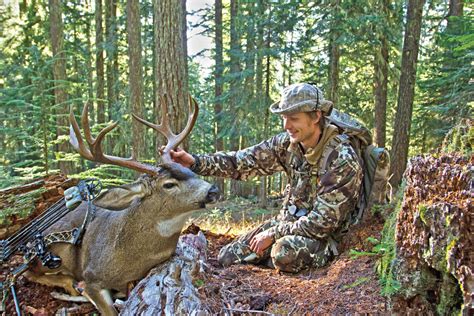How To Hunt Blacktail Deer
Ronan Farrow
Apr 01, 2025 · 3 min read

Table of Contents
How to Hunt Blacktail Deer: A Comprehensive Guide
Hunting blacktail deer can be an incredibly rewarding experience, offering a thrilling challenge and delicious venison. However, success requires careful planning, skill, and a deep understanding of blacktail behavior and habitat. This guide will cover essential aspects to help you increase your chances of a successful hunt.
Understanding Blacktail Deer Habitat
Blacktail deer are highly adaptable but thrive in specific environments. Knowing their preferred habitat is crucial for finding them.
Coastal Blacktails:
- Location: Found in coastal regions, often near brushy areas, redwood forests, and along the edges of meadows.
- Terrain: Steep, rugged terrain is common, requiring good physical fitness and navigation skills.
- Forage: Rely heavily on various plants, shrubs, and grasses found in these coastal environments.
Inland Blacktails:
- Location: Inhabit inland mountains, foothills, and forests, often with mixed coniferous and hardwood trees.
- Terrain: Can be less rugged than coastal areas but still requires attention to elevation changes and dense vegetation.
- Forage: Their diet varies based on the specific region and season, but typically includes browse, acorns, and other forest vegetation.
Pre-Hunt Preparation: Crucial Steps for Success
Proper preparation before you even step foot in the woods dramatically increases your chances of success.
Scouting:
- Importance: Identifying potential hunting spots, observing deer trails, and understanding feeding and bedding patterns are essential.
- Techniques: Utilize trail cameras, binoculars, and even aerial imagery (if available and permitted) to scout effectively.
- Timing: Scout during the off-season or early season to minimize disturbance and maximize your observations.
Gear and Equipment:
- Essential Items: A high-quality rifle or bow, appropriate ammunition or arrows, hunting license, first-aid kit, rangefinder, comfortable hunting boots, quality camouflage clothing, and a backpack to carry essentials.
- Optional but Helpful: Binoculars, spotting scope, GPS device, game calls, scent eliminators.
- Maintenance: Ensure all equipment is properly maintained and in good working order before your hunt.
Understanding Blacktail Behavior:
- Seasonal Movements: Blacktails migrate seasonally depending on food availability and weather conditions. Understanding these patterns is key to finding them.
- Feeding Habits: Learn about their preferred food sources and when they are most likely to feed. This knowledge will help you position yourself effectively.
- Social Structure: Understanding their social dynamics, including buck-to-doe ratios and herd behaviors, can significantly improve your hunting strategies.
Hunting Techniques: Strategies for Success
Choosing the right hunting technique depends on your hunting style, the terrain, and the time of year.
Still Hunting:
- Approach: Slowly and silently move through the woods, using cover and concealment to avoid detection.
- Advantages: Highly effective for close-range shots and can be surprisingly successful.
- Disadvantages: Requires patience, good camouflage, and the ability to remain undetected.
Spot and Stalk:
- Approach: Use binoculars and spotting scope to locate deer from a distance, then carefully stalk closer for a shot.
- Advantages: Allows for long-range shots and can be effective in open or partially forested areas.
- Disadvantages: Requires significant patience, good camouflage, and an understanding of wind direction.
Stand Hunting:
- Approach: Set up a tree stand or ground blind in an area with high deer traffic and wait for deer to come to you.
- Advantages: Offers a great vantage point and allows for long periods of observation.
- Disadvantages: Requires careful stand placement and can be less effective in areas with low deer density.
Ethical Hunting Practices: Respecting the Animal and the Environment
Ethical hunting is paramount. Remember these crucial elements:
- Respect for the Animal: Ensure a clean, quick kill to minimize suffering.
- Respect for the Environment: Leave no trace, pack out all trash, and avoid damaging vegetation.
- Knowing the Law: Always adhere to all hunting regulations and laws specific to your hunting area.
Hunting blacktail deer requires preparation, skill, and respect. By carefully planning your hunt and employing responsible techniques, you can significantly increase your chances of success while enjoying a memorable and ethical hunting experience. Remember always to prioritize safety and abide by all regulations. Good luck!
Featured Posts
Also read the following articles
| Article Title | Date |
|---|---|
| How To Install Green Monster Build | Apr 01, 2025 |
| How To Press Bubble Hash | Apr 01, 2025 |
| How To Make Pokeberry Ink | Apr 01, 2025 |
| How To Hang A Paddle On A Wall | Apr 01, 2025 |
| How To Hunt Blacktail Deer | Apr 01, 2025 |
Latest Posts
Thank you for visiting our website which covers about How To Hunt Blacktail Deer . We hope the information provided has been useful to you. Feel free to contact us if you have any questions or need further assistance. See you next time and don't miss to bookmark.
